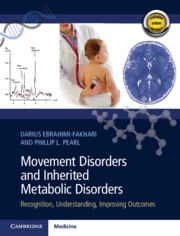Book contents
- Movement Disorders and Inherited Metabolic Disorders
- Movement Disorders and Inherited Metabolic Disorders
- Copyright page
- Dedication
- Contents
- Contributors
- Preface
- Acknowledgments
- Section I General Principles and a Phenomenology-Based Approach to Movement Disorders and Inherited Metabolic Disorders
- Section II A Metabolism-Based Approach to Movement Disorders and Inherited Metabolic Disorders
- Section III Conclusions and Future Directions
- Chapter 30 Metabolic Movement Disorders in the Era of Next-Generation Sequencing
- Chapter 31 Deep Brain Stimulation for Metabolic Movement Disorders
- Chapter 32 Novel Therapeutic Approaches to Metabolic Movement Disorders
- Closing Remarks: A Clinical Approach to Inherited Metabolic Movement Disorders
- Appendix: Video Captions
- Index
- References
Chapter 32 - Novel Therapeutic Approaches to Metabolic Movement Disorders
from Section III - Conclusions and Future Directions
Published online by Cambridge University Press: 24 September 2020
- Movement Disorders and Inherited Metabolic Disorders
- Movement Disorders and Inherited Metabolic Disorders
- Copyright page
- Dedication
- Contents
- Contributors
- Preface
- Acknowledgments
- Section I General Principles and a Phenomenology-Based Approach to Movement Disorders and Inherited Metabolic Disorders
- Section II A Metabolism-Based Approach to Movement Disorders and Inherited Metabolic Disorders
- Section III Conclusions and Future Directions
- Chapter 30 Metabolic Movement Disorders in the Era of Next-Generation Sequencing
- Chapter 31 Deep Brain Stimulation for Metabolic Movement Disorders
- Chapter 32 Novel Therapeutic Approaches to Metabolic Movement Disorders
- Closing Remarks: A Clinical Approach to Inherited Metabolic Movement Disorders
- Appendix: Video Captions
- Index
- References
Summary
Movement disorders are common symptoms in patients with inborn errors of metabolism (IEMs), and have a serious impact on their quality of life. Treatment of the movement disorder is usually causal, i.e. aimed at the underlying condition. More and more therapeutic strategies are emerging for many IEMs, varying from dietary restriction/supplementation, enzyme cofactor/vitamin supplementation, enzyme-replacement, substrate inhibition, substrate reduction, bone marrow or hematopoietic stem-cell transplantation (HSCT), gene therapy, or newer symptomatic treatment modalities. Dietary manipulations typically aim at substrate reduction, i.e. decreasing the intake of toxic precursors or providing the deficient product. Vitamins and cofactors are used because in some disorders the synthesis of these is affected, while in others these catalyze residual enzyme activity and stability, or act as chaperones.
- Type
- Chapter
- Information
- Movement Disorders and Inherited Metabolic DisordersRecognition, Understanding, Improving Outcomes, pp. 393 - 410Publisher: Cambridge University PressPrint publication year: 2020



